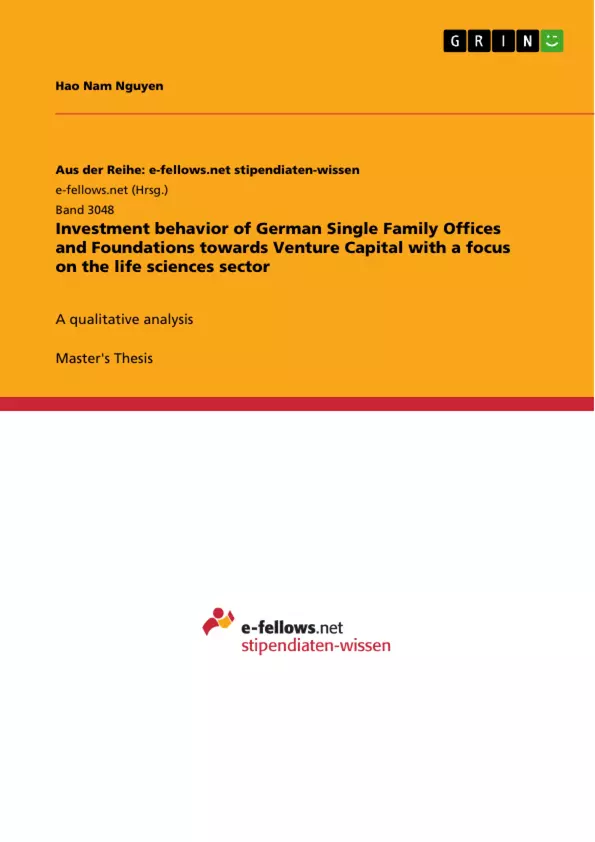VC plays a fundamental role in the financing landscape of young life sciences companies. Hence its availability is a crucial catalyst which can either promote or inhibit the whole development of an industry branch. VC funds are financial intermediaries which raise capital from either institutional or private investors to invest it further into the economy in the form of start-up financing. While there are young, capital-seeking life sciences companies on the demand side, VC funds with their investment capital stand opposite on the supply side. The investment decision process and relationship between the Venture Capitalists (VCs) and the entrepreneurs are well covered research subjects, whereas the decision process and interaction between VC investors or limited partners (LPs) and VCs or general partners (GPs) are left on the sidelines. Looking at the entire VC supply chain, research has so far almost omitted the supply side topic of the investment decision process of institutional or private investors towards VC. Therefore the aim of this thesis is to analyze the investment behavior of German LPs in the form of single family offices (SFOs) and foundations vis-à-vis VC. The objective is to fill a gap in the research on the supply side of VC, specifically in the life sciences sector, through qualitative interviews with a group of institutional and private investors which have been subject to little research to date. Finally, a framework will be developed which seeks to portray the main findings and bridge to applicable economic theories.
Inhaltsverzeichnis (Table of Contents)
- INTRODUCTION
- Background
- Problem Statement
- Purpose and Objective
- Research Question
- Delimitation
- Thesis Structure
- DEFINITION
- Family Office
- Life Sciences Sector
- Venture Capital
- BACKGROUND AND LITERATURE OVERVIEW
- Financing of Life Sciences Start-ups
- Life sciences a challenging sector
- Financing Models
- Active VC investors
- Financing Landscape in Germany
- Entrepreneurial Ecosystem
- Investment behavior of LPs a literature review
- Strategic Influence of Investment Companies
- Agency Theory
- Specialization and Success
- METHODOLOGY
- Research Design
- Data Collection
- Sample
- Semi-structured Interviews
- Inductive Analysis
- Limitations of the Methodology
- Validity
- Reliability
- RESULTS AND ANALYSIS
- Summary of the Inductive Analysis
- Analysis of the Investment Behavior
- Framework Conditions
- Allocation
- Motivation
- Criteria
- Risk
- Entrepreneurial Ecosystem
- Governance
- DISCUSSION
- Investment Behavior of SFOs and Foundations and its Implications for Life Sciences VC Investments
- Classification of the Investment Behavior Categories
- SUMMARY AND CONCLUSIONS
- Summary of Results
- Theoretical Implications
Zielsetzung und Themenschwerpunkte (Objectives and Key Themes)
This master thesis aims to analyze the investment behavior of German Single Family Offices and Foundations towards venture capital in the life sciences sector. The study focuses on identifying the key factors influencing investment decisions and understanding the specific challenges and opportunities associated with this market segment. The research utilizes a qualitative approach through semi-structured interviews to gain insights into the decision-making processes and perspectives of these investors.
- Investment behavior of German Single Family Offices and Foundations in life sciences venture capital
- Factors influencing investment decisions in the life sciences sector
- Challenges and opportunities of investing in life sciences startups
- The role of the entrepreneurial ecosystem in life sciences venture capital
- Governance structures and risk management practices of investors
Zusammenfassung der Kapitel (Chapter Summaries)
- Introduction: This chapter establishes the background of the study, defines the problem statement, and outlines the research question, purpose, and scope. It concludes with a detailed overview of the thesis structure.
- Definition: This chapter provides a clear and concise definition of key terms such as family office, life sciences sector, and venture capital. These definitions provide a common understanding of the terminology used throughout the thesis.
- Background and Literature Overview: This chapter explores the financing landscape of life sciences startups, focusing on the challenges and opportunities presented by this sector. It reviews existing literature on investment behavior of Limited Partners (LPs), including strategic influence, agency theory, and the role of specialization in achieving success.
- Methodology: This chapter outlines the research design, data collection methods, and analytical approach used to conduct the study. It describes the interview sample, the semi-structured interview process, and the inductive analysis technique. Additionally, it addresses limitations of the methodology, including considerations for validity and reliability.
- Results and Analysis: This chapter presents the results of the inductive analysis, summarizing the central categories and subcategories identified through the interviews. It further analyzes the investment behavior of the participating Single Family Offices and Foundations, focusing on framework conditions, allocation, motivation, criteria, risk, the entrepreneurial ecosystem, and governance.
- Discussion: This chapter discusses the implications of the findings for life sciences venture capital investments, classifying the identified categories of investment behavior. It examines the potential impact of these investment behaviors on the future development of the life sciences venture capital market in Germany.
Schlüsselwörter (Keywords)
The key terms and concepts explored in this study include Single Family Offices, Foundations, Venture Capital, Life Sciences, Investment Behavior, Framework Conditions, Allocation, Motivation, Criteria, Risk, Entrepreneurial Ecosystem, Governance, and the German Life Sciences Venture Capital Market. These terms represent the primary focus of the thesis, reflecting the research objectives and themes.
- Arbeit zitieren
- Hao Nam Nguyen (Autor:in), 2018, Investment behavior of German Single Family Offices and Foundations towards Venture Capital with a focus on the life sciences sector, München, GRIN Verlag, https://www.grin.com/document/457590



